 We congratulate Dr Iain Hannah from our group who has taken up his post as one of 41 new Royal Society University Research Fellows (URFs) for 2013, to conduct a research programme into the physics of high energy solar flares. The University Research Fellowship scheme aims to provide outstanding scientists, who have the potential to become leaders in their chosen fields, with the opportunity to build an independent research career. Iain’s research into solar flares involves X-ray imaging and spectroscopy, multi-wavelength studies, statistical surveys and numerical simulations.
We congratulate Dr Iain Hannah from our group who has taken up his post as one of 41 new Royal Society University Research Fellows (URFs) for 2013, to conduct a research programme into the physics of high energy solar flares. The University Research Fellowship scheme aims to provide outstanding scientists, who have the potential to become leaders in their chosen fields, with the opportunity to build an independent research career. Iain’s research into solar flares involves X-ray imaging and spectroscopy, multi-wavelength studies, statistical surveys and numerical simulations.
Big solar flares caught in Glasgow
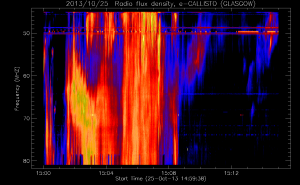 The recent flurry of solar activity has seen several large flares emitted by the Sun. The rapid release of energy in the Sun’s atmosphere heats material and accelerates particles resulting in bright emission seen by a myriad of satellite’s including NASA’s RHESSI. These were also caught by the solar radio telescope at our Acre Rd Observatory, which observes the electrons accelerated to high energies in flares. Our telescope uses a CALLISTO spectrometer and it provides live observations of the Sun at radio frequencies between 45 and 80 MHz with 0.125 second cadence. This strong radio emission can interrupt communications on the ground across many frequencies.
The recent flurry of solar activity has seen several large flares emitted by the Sun. The rapid release of energy in the Sun’s atmosphere heats material and accelerates particles resulting in bright emission seen by a myriad of satellite’s including NASA’s RHESSI. These were also caught by the solar radio telescope at our Acre Rd Observatory, which observes the electrons accelerated to high energies in flares. Our telescope uses a CALLISTO spectrometer and it provides live observations of the Sun at radio frequencies between 45 and 80 MHz with 0.125 second cadence. This strong radio emission can interrupt communications on the ground across many frequencies.
Glasgow Solar Physicists Honoured by NASA
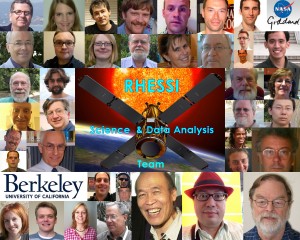 In July the Science and Data Analysis Team working on NASA’s RHESSI satellite was honoured with a NASA Group Achievement Award. Of the 40 members of the team, 9 have strong links with Glasgow University, being current staff members and/or past PhD graduates in Solar Physics. The strong Glasgow representation in this international team builds on the early seminal work of Professor John C. Brown, ex Regius Chair in Astronomy in the School of Physics and Astronomy. The award was made in recognition of the team’s sustained, outstanding scientific achievement over a full solar cycle.
In July the Science and Data Analysis Team working on NASA’s RHESSI satellite was honoured with a NASA Group Achievement Award. Of the 40 members of the team, 9 have strong links with Glasgow University, being current staff members and/or past PhD graduates in Solar Physics. The strong Glasgow representation in this international team builds on the early seminal work of Professor John C. Brown, ex Regius Chair in Astronomy in the School of Physics and Astronomy. The award was made in recognition of the team’s sustained, outstanding scientific achievement over a full solar cycle.
Royal Astronomical Society Specialist Discussion Meeting on the life of solar prominences

SDO/AIA images of a filament on the sun from August 31, 2012. From upper left and going clockwise: 335, 171, 304 and 131 Å channels
Registration is now open for the Royal Astronomy Society Specialist Discussion Meeting devoted to solar prominences on Friday 21st February in the RAS premises in London, UK. Abstracts can be submitted at the meeting web page.
This specialist discussion meeting aims to review our current understanding of the life-cycle of solar prominences. How do they form? How do they interact with their environment, from the photosphere to the corona? How do they disappear? What is their contribution to Space Weather? Addressing these questions relies on interactions between experts in plasma physics, MHD, magnetic field modelling and observation, spectroscopy, radiation transfer, … This will be an excellent opportunity to discuss open issues in this area of interest to solar and stellar physicists, keeping in mind recent and future developments in observations and in modelling.
Dr Peter Levens

PhD Student
I am working with Dr. Nicolas Labrosse and Prof. Lyndsay Fletcher on solar tornado-like prominences – these features appear to be the rotating legs of prominences.
My research has mostly been using UV and EUV observations from the Hinode and IRIS satellites and the ground-based THEMIS telescope in the Canary Islands. In 2014 and 2015 I was part of an international team that coordinated and performed observations with Hinode, IRIS, and THEMIS. I had the opportunity to spend four weeks making observations of prominences at THEMIS as part of that campaign. I also spent four months at the Observatoire de Paris in Meudon, working with Dr. Brigitte Schmieder on analysing IRIS data that we gathered in 2014.
I have also spent some time developing a radiative transfer code that simulates the emission of ionised magnesium (Mg II) lines in prominences. This work has built upon the already-substantial code for modelling hydrogen, helium, and calcium in prominences, provided to me by Dr. Nicolas Labrosse. The aim of this work was to extend previous prominence Mg II models to explain recent IRIS observations.
I am currently at the end of my PhD, writing my thesis.
Publications:
“Comparing UV/EUV line parameters and magnetic field in a quiescent prominence with tornadoes” — P. J. Levens, N. Labrosse, B. Schmieder, A. López Ariste, L.Fletcher. 2017, Astronomy and Astrophysics, (accepted, awaiting publication) [doi] [arXiv]
“Reconstruction of a helical prominence in 3D from IRIS spectra and images” — B. Schmieder, M. Zapiór, A. López Ariste, P. J. Levens, N. Labrosse, R. Gravet. 2017, Astronomy and Astrophysics, (accepted, awaiting publication) [doi] [arXiv]
“Halpha Doppler shifts in a tornado in the solar corona” — B. Schmieder, P. Mein, N. Mein P. J. Levens, N. Labrosse, L. Ofman. 2017, Astronomy and Astrophysics, 597, A109 [doi] [arXiv]
“Magnetic Field in Atypical Prominence Structures: Bubble, Tornado, and Eruption” — P. J. Levens, B. Schmieder, A. López Ariste, N. Labrosse, K. Dalmasse, B. Gelly. 2016, The Astrophysical Journal, 826, 164L [doi] [arXiv]
“Structure of Prominence Legs: Plasma and Magnetic Field” — P. J. Levens, B. Schmieder, N. Labrosse, A. López Ariste. 2016, The Astrophysical Journal, 818, 31L [doi] [arXiv]
“A solar tornado observed by EIS: Plasma diagnostics” — P. J. Levens, N. Labrosse, L.Fletcher, B. Schmieder. 2015, Astronomy and Astrophysics, 582, A27 [doi] [arXiv]
Conference proceedings:
“Prominence and tornado dynamics observed with IRIS and THEMIS” — B. Schmieder, P. J. Levens, N. Labrosse, P. Mein, A. López Ariste, M. Zapiór. 2017, American Astronomical Society, SPD meeting No. 48
“Prominence plasma and magnetic field structure – A coordinated observation with IRIS, Hinode and THEMIS” — B. Schmieder, N. Labrosse, P. J. Levens, A. López Ariste. 2016, 41st COSPAR Scientific Assembly
“Magnetic Field and Plasma Diagnostics from Coordinated Prominence Observations” — B. Schmieder, P. J. Levens, K. Dalmasse, N. Mein, P. Mein, A. López Ariste, N. Labrosse, P. Heinzel. 2016, Astronomical Society of the Pacific, ASP Conference Series, Vol. 504
“Polarimetric measurements in prominences and “tornadoes” observed by THEMIS” — B. Schmieder, A. López Ariste, P. J. Levens, N. Labrosse, K. Dalmasse. 2014, Proceedings of the International Astronomical Union, IAU Symposium No. 305
Contact information:
Room 604
School of Physics and Astronomy
Kelvin Building
University of Glasgow
G12 8QQ
Scotland
Email: p.levens.1@research.gla.ac.uk
Tel: +44 141 330 2960
500 years of Glasgow Astronomy
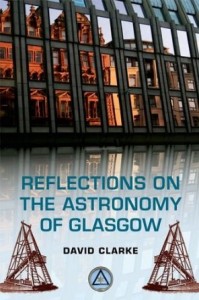
Dr David Clarke (Honorary Research Fellow and ex-Observatory Director) has written a book on the history of astronomy in Glasgow titled “Reflections on the Astronomy of Glasgow: A story of some 500 years” (Edinburgh University Press). In it David describes how astronomy contributed to the educational enlightenment of Glasgow and to its society and commerce.
The book is available at a special price from Edinburgh University Press till 30-Sep-2013 via this form and is also available on amazon.
How Astronomy contributed to the educational enlightenment of Glasgow, to its society and to its commerce
The book provides a comprehensive narrative concerning Glasgow’s connections with Astronomy since the University’s establishment in 1451. It covers the educational and scientific contributions of notable and sometimes notorious individuals, providing biographies of outstanding people, including George Sinclair, the Professors Dick , the Professors Wilson, James Watt, John Pringle Nichol, Robert Grant, Ludwig Becker and William Smart. Through such people, discoveries related to sunspots, the monochromaticity within light, the behaviour of dew-point and the discovery of infra-red radiation remarkably have Glasgow connections.
The early part nineteenth century saw a thirst for astronomical knowledge by the local population with the establishment of two public observatories in the City. The second was rescued financially by the University in 1845 with a remit for establishing a time service for shipping on the Clyde. Following ‘Glasgow’s Big Bang of 1863’, with an unwarranted Edinburgh intrusion for establishing a time-gun, the resulting spat was covered in heated exchanges in the Herald with the editor demeaning of the title of Astronomer Royal for Scotland; in the end the local Horselethill Observatory won out to provide telegraphic time signals for the control of City public clocks. The establishment of eight different observatories is described with details of their architecture.
Overall, the story is a collection of local material and its relationship to the general development of the subject of astronomy, with insights on commercial and social aspects, so supporting a unique picture of astronomical connections with the City of Glasgow.
Group research selected for journal cover image
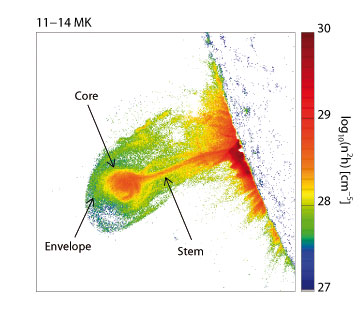
A figure from a recent published paper by group members was chosen as cover image for this month’s volume of the Astronomy & Astrophysics journal. The image shows a map of heated plasma ejected from the corona and the paper (Hannah & Kontar, A&A v553 A10 2013) is focused on a method to obtain maps of the emission as a function of temperature from observations of a coronal mass ejection (CME) observed by NASA’s SDO/AIA.
Auroras Shine Light On Solar Flares — Group Research in University News
Solar flares are huge cosmic blasts of UV light, X-rays and high-energy particles from the Sun that can damage power grids and satellites. Inspired by the Northern Lights, Dr Alexander Russell and Dr Lyndsay Fletcher have shown how magnetic waves could help move energy tens of thousands of kilometres in less than a second to power flares.
See the story at: http://www.gla.ac.uk/news/headline_270276_en.html
Read the paper at: http://iopscience.iop.org/0004-637X/765/2/81/
Natasha Jeffrey awarded Thomson prize
Natasha Jeffrey was awarded Thomson prize in recognition of excellent work on her PhD studies.
Dr Hamish Reid
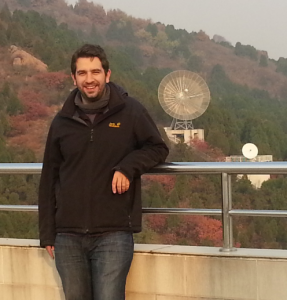
My research efforts are focussed towards the active Sun, in particular with flares and electron beams. To investigate this phenomena I use multi-wavelength observational studies with a particular focus on radio and X-ray wavelengths. I also use numerical simulations to model electron transport including the kinetic plasma processes that are involved with generating the radio emission we observe in space weather.
Room 608
School of Physics and Astronomy
Kelvin Building
University of Glasgow
G12 8QQ
Scotland
Email: hamish.reid@glasgow.ac.uk
Tel: +44 141 330 5388
Fax: +44 141 330 8600
Dr Iain Hannah awarded RAS Fowler Prize
Dr Iain Hannah has been awarded the Fowler Prize for geophysics by the Royal Astronomical Society. This prize, awarded annually, honours individuals who have made a particularly noteworthy contribution at any early stage of their career. See here for details.
Memorial service for Professor Archie Roy
We are deeply saddened to report that Professor Archie Roy passed away on December 27 aged 88. Most of the current A&A group knew Archie well, and we have lost a good friend. Archie was an active member of the group, well into his 80s. We will miss his humour, zestful enthusiasm and seemingly boundless energy in everything he did over a remarkable career.
A Memorial Service and Tribute to the late Professor Archie Roy will be held in Glasgow University Chapel on Thursday March 14 at 14.30 and will be followed by a reception in Hunter Hall West approx 15.30-17.00. All are welcome.
Update: Professor Archie Roy’s Memorial Service two weeks ago included a short film, made by his son Ian, showing photos from Archie’s life. The family has made the film available at
http://vimeo.com/iandroy/archieroymemorialslideshow.
Solar ALMA Workshop
The Atacama Large Millimeter/submillimeter Array (ALMA), an international partnership of Europe, North America and East Asia in cooperation with the Republic of Chile, is the largest astronomical project in existence.
The workshop (see details here….) aims to bring together the ALMA-minded solar community to discuss solar observational issues with ALMA, solar science and planned observations with ALMA, and the planning of solar ALMA observations.
Th workshop is hosted by Astronomy & Astrophysics Group, and will take place in School of Physics and Astronomy, University of Glasgow.
First light observations by e-Callisto at Acre Rd Observatory
Dr Salma Islam
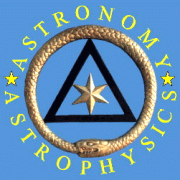
PhD Student
I am working with Prof. Martin Hendry.
Room 604
School of Physics and Astronomy
Kelvin Building
University of Glasgow
G12 8QQ
Scotland
Email: s.islam.1@research.gla.ac.uk
Tel: +44 141 330 2960
Fax: +44 141 330 8600
Dr Duncan Stackhouse

PhD Student
I work on electron acceleration in Solar Flares. Taking a particular interest in the distribution of these electrons and processes behind the acceleration.
Room 604
School of Physics and Astronomy
Kelvin Building
University of Glasgow
G12 8QQ
Scotland
Email: d.stackhouse.1@research.gla.ac.uk
Tel: 2960
Fax: +44 141 330 8600
Dr Graham Kerr
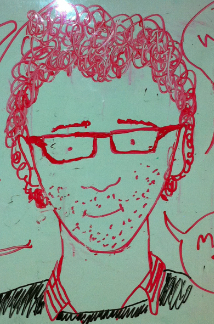 PhD Student
PhD Student
I have now completed my PhD, which was supervised by Prof Lyndsay Fletcher, and am about to start a postdoctoral fellowship at NASA’s Goddard Space Flight Center (~April 2017).
My research interests are in solar physics, particularly in energy and radiation transport through the solar atmosphere during solar flares. I have expertise in data analysis using both imaging and spectroscopic observations from the Hinode, IRIS and SDO spacecraft, as well as using the numerical codes RADYN and RH to simulate solar flares, and the radiation they produce. I am eager to use a combination of both observations and numerical simulations to better understand the processes involved in solar flares.
Publications
“Simulations of the Mg II k and Ca II 8542 lines from an Alfvén Wave-heated flare chromosphere”, G.S. Kerr, L. Fletcher, A.J.B. Russell, & J.C. Allred. The Astrophysical Journal, vol. 827 (2), 2016. [doi]
“IRIS Observations of the Mg II h & k Lines During a Solar Flare”, G.S. Kerr, P.J.A. Simões, J. Qiu & L. Fletcher. Astronomy and Astrophysics, vol. 582 (A50), 2015. [doi]
“The Radiated Energy Budget of Chromospheric Plasma in a Major Solar Flare Deduced from Multi-Wavelength Observations”, R.O. Milligan, G.S. Kerr, B.R. Dennis, H.S. Hudson, L. Fletcher, J.C. Allred, P.C. Chamberlin, J. Ireland, M. Mathioudakis, & F.P. Keenan. The Astrophysical Journal, vol. 793 (2), 2014. [doi]
“Physical Properties of White-Light Sources in the 2011 Feb 15 Solar Flare”, G.S. Kerr & L. Fletcher. The Astrophysical Journal, vol. 783 (2), 2014. [doi]
“Hard X-ray and Ultraviolet Observations of the 2005 January 15 Two Ribbon Flare”, J. Cheng, G.S Kerr, & J. Qiu. The Astrophysical Journal, vol. 744 (1), 2012. [doi]
Conference Proceedings
“Observations and modelling of Helium lines in solar flares”, P.J.A. Simões, L. Fletcher, N. Labrosse, & G.S. Kerr. In: Coimbra Solar Physics Meeting 2015: Ground-based Solar Observations in the Space Instrumentation Era. ASP Conference Series, Vol. 504, 2016.
A C.V can be found here.
I am active in public outreach, and throughout the 2015-2016 academic year I worked with St. Vincent’s Primary School in East Kilbride as part of the Rolls-Royce Science Prize. Our team was awarded second place with a project that was focused on the ‘Earth in Space’. To learn more about our entry click here.
Room 604
School of Physics and Astronomy
Kelvin Building
University of Glasgow
G12 8QQ
Scotland
Email: Graham.s.kerr@nasa.gov
Tel: +44 141 330 2960
SUPA Cormack Astronomy Meeting
The Scottish Universities Physics Alliance and the Royal Royal Society of Edinburgh (Cormack Bequest) will hold a one-day Scottish astronomy meeting, SCAM2012, on Tuesday 13th November 2012 at the Royal Society of Edinburgh. More information is available here.
The programme is particularly relevant to research students and staff working in Scottish universities and gives the opportunity for them to meet, discuss research and hear about new developments in the field. Coffee and lunch are included.
There is no registration fee for this meeting, but if you plan on attending please complete the online registration form. There is the opportunity to present your work at a general interest level in a 20 minute talk, or, for more focussed research, through an extensive poster session which will be judged in a competition.
Workshop on High Energy Flare Physics, 25-26 June 2012
This workshop is a continuation of the Alliance workshops held under the Franco-British partnership research programme in 2009-2011.
Transit of Venus 2012 event
 On June 5th and 6th 2012 the world will witness a very special astronomical event: a Transit of Venus across the disk of the Sun. Such transits are extremely rare: only six have been observed throughout recorded history and the next transit will not occur until 2117.
On June 5th and 6th 2012 the world will witness a very special astronomical event: a Transit of Venus across the disk of the Sun. Such transits are extremely rare: only six have been observed throughout recorded history and the next transit will not occur until 2117.
To mark the transit we are hosting a celebration at Glasgow University that will link up with transit observers around the world and (hopefully) culminate with observing the transit here in Glasgow early on June 6th. Also in recognition of the huge historical significance of this event and to mark the launch of Glasgow Science Festival 2012, you are warmly invited to join us for an all-night celebration of the Transit in Glasgow.
If you’re interested in finding out more about this event (or indeed in participating) the website is now up and running.
Prize International Internship: “Computer Vision for Space Applications”
An exciting opportunity for an outstanding intern to work on a project entitled “Computer Vision for Space Applications” has arisen in the College of Science and Engineering at the University of Glasgow.
Images in science carry a lot of information. As image resolution increases, extracting information in a timely manner and providing it to end-users is more and more challenging. It requires analysing and interpreting automatically a large amount of data from different instruments, as well as rapid and robust image processing algorithms such as feature extraction, image mosaic and time series analysis.
Depending on the preferences of the successful candidate, the intern will focus on one or more of the following areas:
− Feature extraction: the intern will develop computer vision tools to automatically extract and classify features of interest from satellite images.
− Time-tracking: the intern will implement time-tracking algorithms to perform crucial time series analyses to reveal trends and processes from the data.
− Benchmarking: the intern will design test cases allowing reliable comparisons between different algorithms developed by the project leaders to assess and enhance their performance and robustness.
The project will last for ten weeks with a start date preferably between 15th and 30th June 2012. IDL programming skill is highly desirable. To apply, please email the following documents to both Dr Labrosse and Dr Li: (1) a one-page CV including academic grades, (2) a brief statement of why you are interested in this project and how you fit the proposed projects, and (3) one letter of reference. Deadline is 31 May 2012.
Contact Dr Nicolas Labrosse (School of Physics and Astronomy) and Dr Zhenhong Li (School of Geographical and Earth Sciences) for further information.
ALMA workshop, Glasgow, May 14, 2012
ALMA/CASA workshop with solar emphasis will be held at Glasgow University on Monday, May 14. The agenda and timetable can be found at the UK ALMA homepage http://www.alma.ac.uk/events/glasgow-workshop (courtesy of George Bendo). Organiser and further info email Eduard Kontar.
Happy 10th Birthday RHESSI
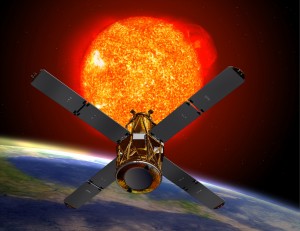
NASA’s Reuven Ramaty High Energy Solar Spectroscopic Imager (RHESSI) was launched 10 years ago on 5 Feb 2002. Its unprecedented view of the high energy X-ray and γ-ray emission from solar flares has provided many insights into these explosive phenomena. The Glasgow A&A group are heavily involved with analysing and interpreting the data from RHESSI, with these results recently reviewed by group members in the RHESSI monograph.
Dr. Craig Stark

Now based at the University of St. Andrews
Astronomy Summer Research Projects
Astronomy and Astrophysics Group offers a number of undergraduate Summer Vacation Research Projects in the field of Astronomy. Second, third, and forth year students are invited to contact the potential supervisor and discuss the project.
More details can be found here.
